How to Optimize Your Laser Engraving Equipment for Maximum Performance
Share
Laser engraving has become a popular method for personalizing and customizing products. Whether you are using it for your business or hobby, having a well-optimized laser engraving equipment is crucial for achieving high-quality results. In this article, we will discuss the steps you can take to optimize your laser engraving equipment for maximum performance.
Why Optimization is Important for Laser Engraving Equipment
Optimizing your laser engraving equipment is essential for several reasons. First and foremost, it ensures that your equipment is running at its best, which results in high-quality engravings. It also helps to prolong the lifespan of your equipment and reduce the frequency of maintenance and repairs, saving you time and money in the long run.
Additionally, optimizing your laser engraving equipment can also increase its efficiency, allowing you to produce more engravings in a shorter amount of time. This is especially crucial for businesses that need to meet high demands and deadlines.
Step 1: Choose the Right Laser Engraving Equipment
The first step in optimizing your laser engraving equipment is to choose the right one for your needs. There are various types of laser engravers available in the market, each with its own strengths and limitations. For example, Ortur and Aufero offer high-quality and versatile laser engravers that are suitable for both personal and business use. DAJA, on the other hand, specializes in industrial-grade laser engravers that are capable of handling heavy-duty tasks.
When choosing a laser engraver, consider the type of materials you will be engraving, the size of your engravings, and your budget. It is also essential to research and read reviews to ensure that you are investing in a reliable and high-quality laser engraver.
Step 2: Keep Your Laser Engraving Equipment Clean
A clean laser engraver is a well-functioning laser engraver. Regularly cleaning your equipment not only helps to maintain its appearance but also ensures that it is operating at its best. Dust and debris can accumulate on the lens and mirrors, affecting the quality of your engravings. It is recommended to clean your laser engraver after every use and perform a thorough cleaning at least once a month.
Use a soft brush or compressed air to remove any debris from the lens and mirrors. You can also use a lens cleaning solution and a lint-free cloth to clean the lens and mirrors. Be careful not to use any harsh chemicals or abrasive materials that can damage the delicate components of your laser engraver.
Step 3: Calibrate Your Laser Engraving Equipment
Calibrating your laser engraving equipment is crucial for achieving precise and accurate engravings. This process involves adjusting the focus and alignment of the laser beam to ensure that it is hitting the intended spot on the material. Most laser engravers come with a calibration tool or instructions on how to calibrate the machine. If you are unsure, it is best to consult the manufacturer or seek professional help.
Step 4: Use High-Quality Materials
The quality of the materials you use for engraving can greatly affect the performance of your laser engraving equipment. Low-quality or inconsistent materials can result in poor engraving results and even damage your equipment. Invest in high-quality materials, such as wood, acrylic, and metal, for the best results.
It is also essential to consider the thickness and hardness of the materials. Some laser engravers may not be able to handle thicker or harder materials, so make sure to check the specifications of your equipment before attempting to engrave on them.
Step 5: Optimize Your Engraving Settings
The settings you use for your engravings can greatly impact the quality and speed of the results. Experiment with different settings, such as power, speed, and resolution, to find the optimal combination for your desired results. Keep in mind that different materials may require different settings, so it is essential to test and adjust accordingly.
Step 6: Perform Regular Maintenance
Just like any other equipment, laser engravers require regular maintenance to keep them in top condition. This includes cleaning, lubricating moving parts, and checking for any wear and tear. It is also essential to follow the manufacturer's recommended maintenance schedule to ensure that your equipment is operating at its best.
Conclusion
Optimizing your laser engraving equipment is crucial for achieving maximum performance and high-quality results. By choosing the right equipment, keeping it clean, calibrating it, using high-quality materials, and optimizing your settings, you can ensure that your laser engraving business or hobby is running at its best.
